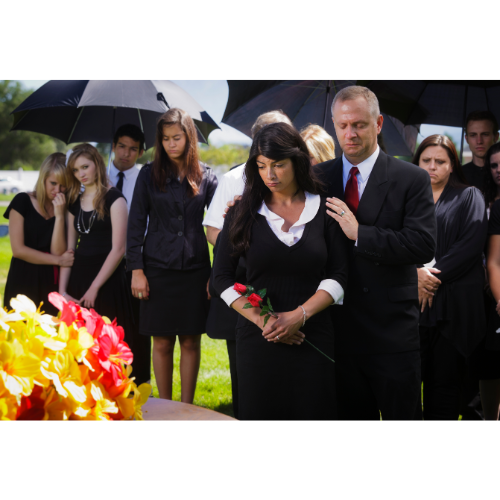What Should I Wear To A Funeral To Show Respect?
Discover the proper attire to wear to a funeral in order to show respect. Opt for conservative and subdued clothing that reflects the significance of the occasion.
Attending a funeral is an occasion that calls for utmost respect and sensitivity. Understanding how to appropriately dress for this somber event is crucial in order to convey your sincere condolences and pay your respects to the grieving family. Taking into account the solemnity of the occasion, opt for subdued and conservative attire that reflects the significance of the event, while also showing your support and sympathy for those mourning the loss of a loved one.
Choosing the Right Attire
When attending a funeral, it is important to choose the right attire as an act of respect for the deceased and their grieving family. Dressing appropriately shows that you understand the solemnity of the occasion and want to honor the memory of the person who has passed away. In order to ensure you dress appropriately for a funeral, it’s essential to take into consideration the formality of the event, cultural and religious customs, weather conditions, and your age.
Formal and Conservative Attire
Funerals are often formal occasions, and it is crucial to dress in a conservative manner. Choosing attire that is neat, well-fitted, and appropriate for the occasion is essential. Avoid clothing that is revealing, casual, or overly trendy, as it may be seen as disrespectful or inappropriate. Opt for clothing that covers your shoulders and knees, as well as clothing that is not excessively tight or sheer.
Colors to Consider
Traditionally, black and darker colors have been associated with mourning and funerals in many cultures. However, today, many believe that wearing darker shades is not a strict requirement. While black remains a safe and respectful choice, wearing other dark, subdued colors such as navy blue, gray, or deep burgundy is also acceptable. It is generally advised to avoid wearing bright colors, such as vibrant red or neon hues, as they may be seen as disrespectful or symbolize celebration rather than mourning.
Avoiding Inappropriate Clothing
It is important to steer clear of clothing that could be deemed inappropriate or disrespectful at a funeral. This includes clothing that is too casual, such as jeans, t-shirts, or shorts, as well as clothing that is overly revealing or flashy. It is generally best to err on the side of dressing more formally than casually, as it shows respect for the grieving family and the solemnity of the occasion.
For Men
When it comes to men’s funeral attire, the traditional choice is a suit and tie. This classic combination exudes professionalism and respect. Opt for a well-tailored suit in a dark color, such as navy, charcoal gray, or black. Pair it with a crisp, long-sleeved dress shirt that complements the suit color. Complete the look with a conservative tie, preferably in a solid or subtle pattern.
Color Options for Men
While black is a common and traditional choice for men’s funeral attire, it is not the only option. Dark charcoal gray and navy blue suits are also appropriate and considered respectful choices. Match the suit color with a complementary dress shirt and tie, avoiding bright or attention-grabbing colors. Remember, the goal is to show respect and blend in, rather than draw attention to yourself.
Accessories and Grooming
Keep accessories and grooming to a minimum when dressing for a funeral. Avoid flashy or colorful accessories, opting instead for subtle and minimalistic choices. A simple watch and a discreet lapel pin would be appropriate choices. Additionally, ensure your hair is well-groomed and facial hair, if applicable, is neatly trimmed. It’s important to present a polished and respectful appearance.
For Women
Women have a variety of options when it comes to funeral attire, but the key is to choose clothing that is modest, conservative, and respectful. Dresses and skirts are commonly worn, but pantsuits can also be a suitable and dignified choice.
Dresses and Skirts
When selecting a dress or skirt for a funeral, choose styles that are modest and not overly revealing. Opt for knee-length or longer hemlines, as showing too much leg may be seen as inappropriate. It’s important to select fabrics and designs that are not overly flashy or attention-grabbing. Neutral or dark-colored dresses or skirts are often the best choice for funerals.
Appropriate Necklines and Lengths
When it comes to necklines, it is best to choose modest options. Plunging necklines or strapless dresses should be avoided, as they may draw attention away from the purpose of the event. Opt for higher necklines, such as crew neck or V-neck styles that are not overly revealing. Similarly, choose sleeves that cover your shoulders, or consider pairing a dress or skirt with a lightweight cardigan or jacket for added modesty.
Choosing the Right Colors
While black is a traditional choice for funeral attire, women can also opt for other dark or subdued colors. Navy blue, charcoal gray, and deep burgundy are all appropriate choices. Avoid wearing bright or vibrant colors, as they may come across as disrespectful or inappropriate for the occasion. The goal is to blend in and show respect for the deceased and their family.
For Children
When it comes to dressing children for a funeral, it’s important to consider their age and choose age-appropriate attire. Dressing children in a manner that is respectful and modest will teach them about the solemnity of the occasion and how to behave respectfully in the future.
Age-Appropriate Attire
For younger children, it is best to dress them in traditional, formal clothing such as dresses or dress shirts with pants. Opt for clothing that covers their arms and legs, avoiding outfits that are overly casual, such as jeans or t-shirts. For infants, choose simple and comfortable clothing that allows for easy movement and diaper changes.
Keeping it Simple and Modest
Children’s clothing should be kept simple and modest, without excessive embellishments or bright colors. Choose neutral or dark shades that align with the general tone of a funeral. Avoid clothing with loud patterns or characters that may detract from the seriousness of the occasion. Ultimately, the focus should be on showing respect and empathy for the grieving family.
Shoes and Accessories
When selecting footwear and accessories for a funeral, comfort and modesty should be prioritized. It is important to choose shoes and accessories that are respectful and not overly flashy or attention-grabbing.
Choosing Comfortable and Respectful Footwear
Opt for closed-toe shoes that are comfortable to wear for an extended period. Avoid sandals or flip-flops, as they can be seen as too casual for a funeral. Choose shoes that are appropriate for the weather conditions and that coordinate well with your chosen outfit. Remember, the goal is to blend in and show respect, so style and comfort should go hand in hand.
Minimal and Subtle Accessories
When it comes to accessories, less is often more for a funeral. Avoid wearing excessive jewelry or accessories that may distract from the purpose of the ceremony. Opt for simple and understated pieces such as small earrings, a discreet necklace, or a classic watch. The focus should be on paying tribute to the deceased, not on personal style or fashion statements.
Considering Cultural and Religious Customs
When attending a funeral, it is important to be mindful of cultural and religious customs that may influence appropriate attire. Different cultures and religions have unique practices and expectations when it comes to funeral dress codes.
Researching the Cultural and Religious Practices
Before attending a funeral, do some research to understand any specific cultural or religious practices that may influence your attire choices. For example, some religions may require specific head coverings, such as a hijab or a yarmulke. It is important to respect and honor these customs by dressing accordingly.
Adhering to Specific Dress Codes
Certain cultures or religious traditions may have specific dress codes for funerals. Traditional funeral attire might include wearing all white, specific colors, or certain types of clothing. It is crucial to familiarize yourself with these requirements and adhere to them respectfully. By doing so, you demonstrate your understanding and appreciation for the traditions and beliefs of the deceased and their family.
Outfit Etiquette
When attending a funeral, it is essential to be mindful of outfit etiquette. This means avoiding clothing that may draw attention to yourself or be seen as disrespectful.
Avoiding Attention-Grabbing Outfits
Avoid wearing outfits that are flashy, overly stylish, or attention-grabbing. Funerals are not the time to showcase your fashion-forward choices or make a bold statement. Keep your attire respectful and subdued, allowing the focus to be on honoring the deceased and supporting their loved ones.
Dressing Modestly and Respectfully
Choose clothing that is modest and respectful of the occasion. Avoid clothing that is too revealing, casual, or provocative. Ensure that your clothing is clean, pressed, and well-maintained. By dressing in a respectful and appropriate manner, you show empathy and understanding to the grieving family and contribute to a calming and supportive atmosphere.
Weather Considerations
Depending on the season and location, weather conditions can greatly impact your choice of funeral attire. It is important to consider the weather and dress accordingly, while still maintaining the appropriate level of formality and respect.
Layering and Weather-Appropriate Clothing
If the funeral is taking place during colder months or in a chilly location, consider layering your clothing to ensure comfort and warmth. Opt for a tailored coat or jacket that complements your outfit. Similarly, if the funeral is occurring in a hot or humid climate, choose lightweight and breathable fabrics to keep cool. The key is to strike a balance between weather-appropriate clothing and respectful attire.
Paying Attention to Funeral Service Type
Different types of funeral services may call for specific attire. The nature of the service, whether traditional, celebration of life, or graveside, can affect your dress choices.
Traditional Funeral
For a traditional funeral service held in a place of worship or funeral home, it is best to adhere to formal and conservative attire. Traditional expectations for funeral attire, such as dark colors and suits or dresses, are generally appropriate for this type of service. Follow the guidance outlined earlier for men, women, and children’s attire, ensuring you convey respect and solemnity.
Celebration of Life or Memorial Service
Celebration of life or memorial services are often less formal than traditional funerals and may take place in non-religious settings. While there may be more flexibility in attire, it is still important to dress appropriately and respectfully. Opt for attire that is conservative, modest, and aligns with the tone of the service. Pay attention to the preferences of the deceased and their family, as they may have expressed specific dress code requests or desired a celebratory atmosphere.
Graveside Service
Graveside services are typically more casual and often take place outdoors. While this type of service may allow for slightly more relaxed attire, it is still important to dress respectfully and keep the focus on honoring the deceased. Opt for conservative and weather-appropriate clothing, with the understanding that you may be standing on uneven terrain or encountering varying weather conditions.
In summary, dressing appropriately for a funeral is a way of showing respect for the deceased and their grieving loved ones. Whether you are a man, or woman, or attending with children, selecting formal and conservative attire is key. Opt for dark or subdued colors, choose modest necklines and lengths, and be mindful of cultural and religious customs. Remember, the goal is to blend in, show respect, and create a supportive environment for those who are mourning. By choosing the right attire, you are honoring the memory of the deceased and supporting their family during a difficult time.

